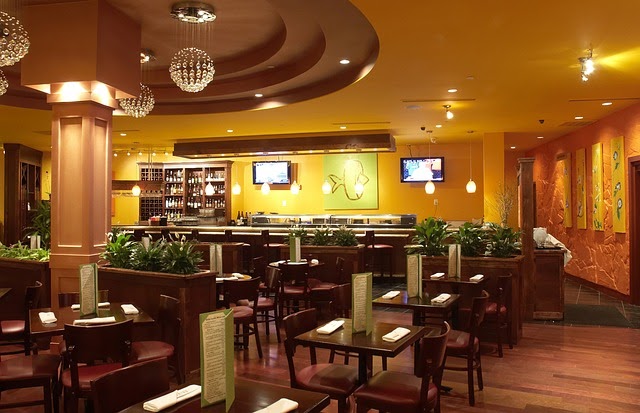Savor Authentic Eastern Food With a Pan-Asian Twist for a Culinary Adventure
Getting started on a cooking trip through genuine Asian cuisine, improved with a Pan-Asian twist, offers an one-of-a-kind opportunity to explore the rich tapestry of flavors that define the area's varied cooking customs. This experience invites you to relish the splendid equilibrium of tastes-- pleasant, salted, spicy, and sour-- balanced by fragrant herbs and spices. Picture the ingenious fusion of Thai curry and ramen or the unforeseen joy of sushi burritos. As you consider these tempting recipes, take into consideration the social narratives and historic impacts that shape them, each bite offering a story waiting to be found.

Checking Out Pan-Asian Tastes
In the realm of worldwide gastronomy, Pan-Asian cuisine stands apart for its amazing variety and the harmonious interplay of tastes from numerous Eastern cultures. This culinary strategy commemorates the abundant practices and unique components located throughout the continent, creating a tapestry of preferences that is both appealing and enjoyable. Secret to Pan-Asian food is its capability to balance contrasting flavors-- pleasant, salty, spicy, and sour-- while highlighting the freshness and quality of each ingredient.
From the umami-rich soy sauce of Japan to the intense chili peppers of Thailand, Pan-Asian food offers a comprehensive combination of tastes. These aspects are frequently incorporated in inventive ways, improving recipes with layers of intricacy. For example, using great smelling natural herbs such as lemongrass and cilantro, common in Vietnamese and Thai food, includes a refreshing illumination to dishes, while the unification of coconut milk provides a luscious, rich texture.
The emphasis on fresh produce and aromatic flavors makes certain that each dish is not just a feast for the palate yet additionally for the senses. Pan-Asian cuisine invites diners to embark on a culinary journey, exploring the vast and varied landscapes of Oriental gastronomy with every bite.
Fusion Dishes to Attempt
While Pan-Asian food is commemorated for its conventional tastes, the modern cooking landscape is increasingly welcoming blend dishes that mix these classic elements with influences from other areas. This cutting-edge approach not only honors the abundant heritage of Asian culinary arts yet likewise introduces unique taste experiences that appeal to modern palates.
An archetype of such a fusion meal is the Korean-Mexican taco, where marinaded bulgogi beef is wrapped in a cozy tortilla, topped with kimchi and a hot gochujang-infused salsa. This mix marries the vibrant, savory flavors of Korea with the dynamic, fresh aspects of Mexican food. In a similar way, sushi burritos have actually obtained popularity, amalgamating the fragile artistry of Japanese sushi with the hearty, hand-held comfort of a burrito, usually including blend components like tempura shrimp and avocado with a drizzle of wasabi mayo.
Another significant meal is Thai curry ramen, which instills the luscious, aromatic flavors of Thai curry into the reassuring broth of conventional Japanese ramen, producing a harmonious mix that entices the senses. These combination meals prolong past simple uniqueness; they represent a cooking dialogue between societies, urging exploration and technology on the planet of Pan-Asian cuisine.
Necessary Active Ingredients and Spices
To genuinely appreciate Pan-Asian food, one should understand the vital components and seasonings that create its structure. This varied cooking style draws from a rich tapestry of Oriental customs, using a harmonious blend of textures and tastes. Trick active ingredients consist of soy sauce, fish sauce, and oyster sauce, which present a savory umami depth vital to Asian dishes. Corresponding to these are rice vinegar and mirin, lending a fragile level of acidity and sweet taste.
Aromatic elements are crucial, with garlic, lemongrass, and ginger being common across numerous Pan-Asian recipes. These active ingredients give a great smelling base that improves the complexity of flavors. Seasonings such as star anise, cardamom, and cinnamon introduce warmth and personality, echoing influences from areas like China and India.

Food Preparation Methods and Tips
Mastering the art of Pan-Asian cuisine calls for familiarity with its distinctive cooking methods, each adding to the lively tapestry of tastes this cooking practice is commemorated for. Central to these techniques is the stir-fry, a fast cooking strategy that preserves the nutritional honesty and dazzling colors Extra resources of components. Utilizing a frying pan, the stir-fry technique enables also warm distribution, crucial for attaining the characteristic texture and flavor balance of Pan-Asian meals.
An additional fundamental strategy is steaming, particularly common in Chinese food. This mild method maintains the all-natural flavors and nutrients of components, making it perfect for seafood dairy queen copyright and veggies. Dumplings, a beloved staple, frequently take advantage of steaming, leading to soft, succulent appearances.
Grilling, also essential, passes on smoky midsts to dishes such as Korean bulgogi or Japanese yakitori (pan asian restaurant Islamabad). This method commonly involves marinading ingredients, permitting flavors to permeate deeply prior to food preparation over an open fire or warmer
Last but not least, grasping the art of stabilizing tastes-- sweet, sour, salted, bitter, and umami-- is critical. Properly layering these aspects can raise a meal from average to extraordinary, supplying a facility and satisfying cooking experience that embodies the significance of Pan-Asian food.
Dining Experiences Worldwide
Around the world, Pan-Asian cuisine uses an exceptional dining experience, commemorated for its abundant tapestry of flavors and vibrant discussions. This culinary sensation has actually transcended cultural limits, recording the hearts and tastes of food lovers worldwide. In worldwide cities fresh York, London, and Sydney, Pan-Asian dining establishments work as fusions where culinary practices from Thailand, Japan, China, and beyond converge, offering diners with a diverse mix of recipes that highlight the region's diversity.
The worldwide appeal of Pan-Asian food depends on its capability to offer both credibility and advancement. Cooks masterfully wed typical components such as lemongrass, soy sauce, and miso with contemporary techniques, leading to meals that are both familiar and refreshingly new. This combination allows diners company website to get started on a cooking trip that values heritage while embracing modernity.
Moreover, dining experiences are elevated with thoughtfully made atmospheres that reflect the values of Pan-Asian appearances. From minimal Japanese-inspired interiors to vibrant Thai-themed areas, each restaurant supplies a special atmosphere that complements the cooking offerings. Because of this, customers are not merely consuming a dish but partaking in a cultural experience, making Pan-Asian eating a truly global sensation.
Final Thought
The exploration of Pan-Asian food supplies a profound understanding of the detailed interplay of tastes and cooking practices throughout Asia. By welcoming blend dishes such as Thai curry ramen and sushi burritos, the culinary trip not only highlights the versatility of traditional active ingredients yet likewise showcases innovative modern methods. This gastronomic journey, improved by cooking techniques and important spices, offers a distinct possibility to appreciate the social diversity and cooking artistry that specify Pan-Asian cuisine on a worldwide scale.
Getting started on a cooking trip through authentic Asian food, improved with a Pan-Asian spin, uses an one-of-a-kind opportunity to explore the rich tapestry of flavors that specify the area's diverse cooking traditions.In the world of global gastronomy, Pan-Asian cuisine stands out for its remarkable diversity and the harmonious interaction of tastes from different Oriental societies. Key to Pan-Asian food is its capability to stabilize different tastes-- sweet, salted, spicy, and sour-- while highlighting the freshness and top quality of each active ingredient.
